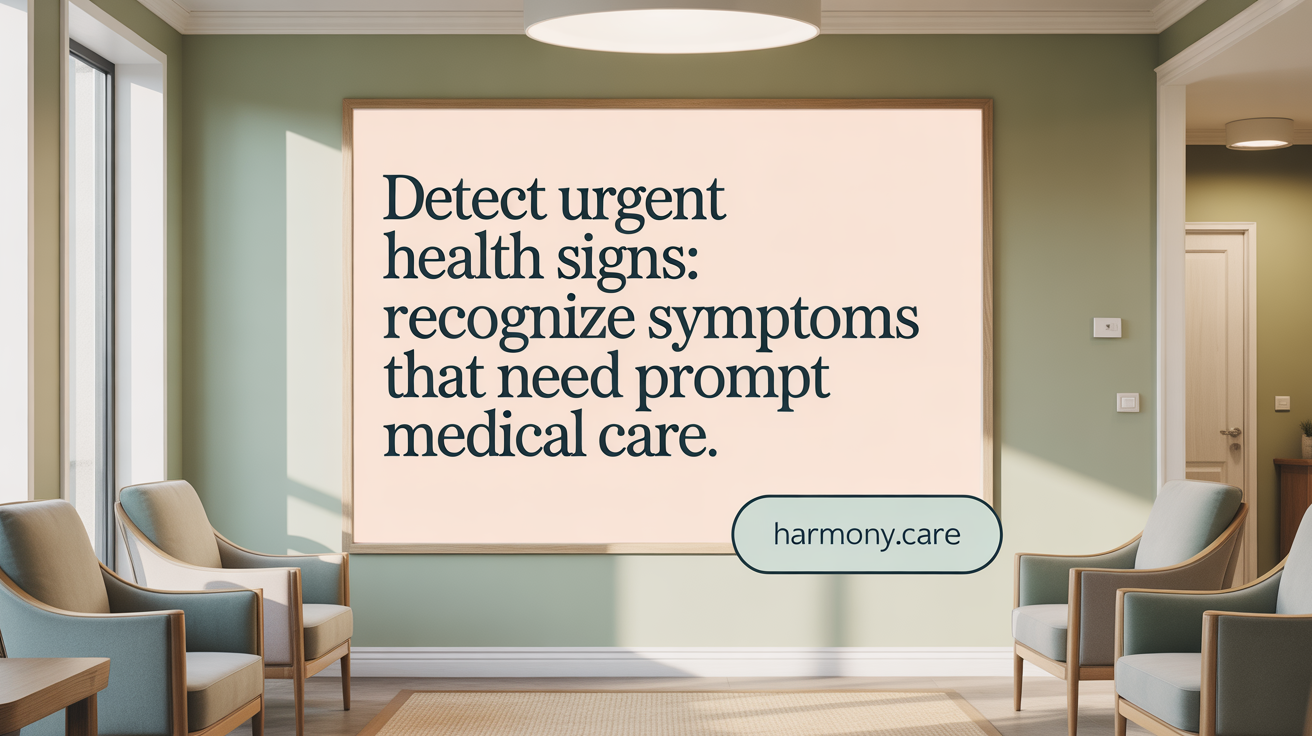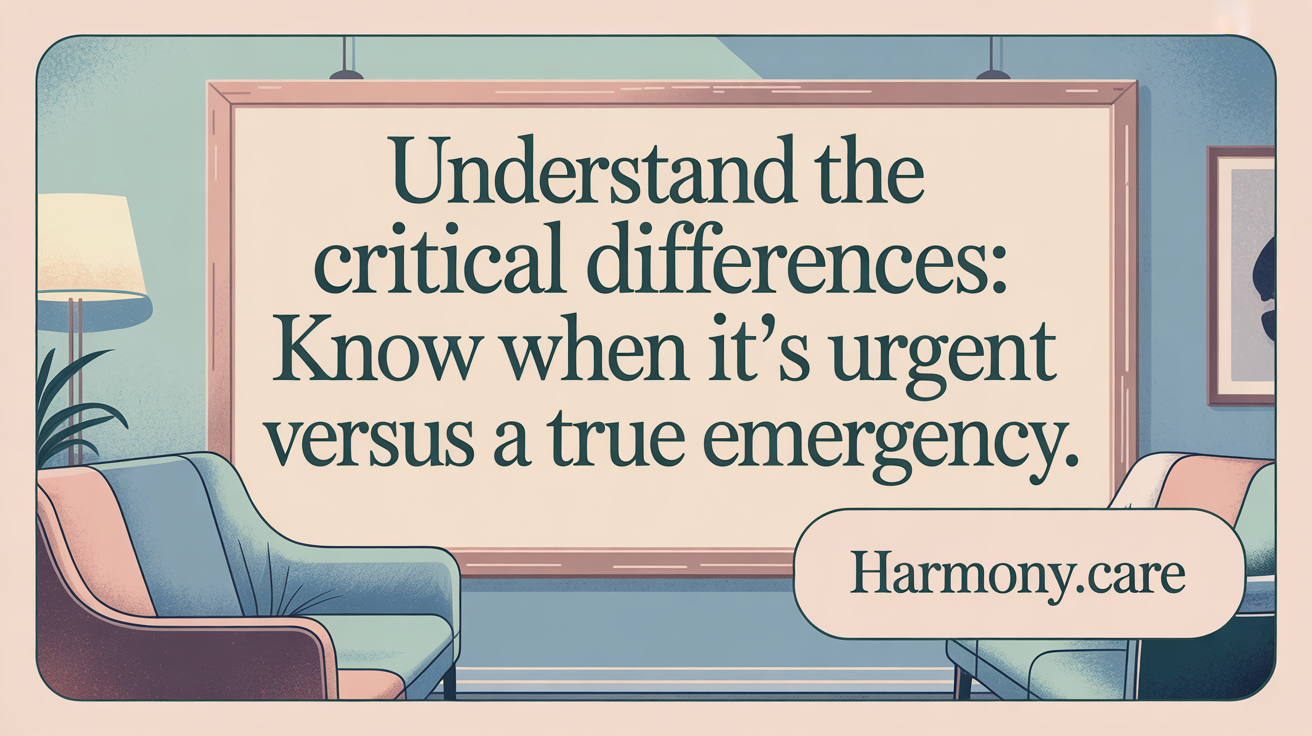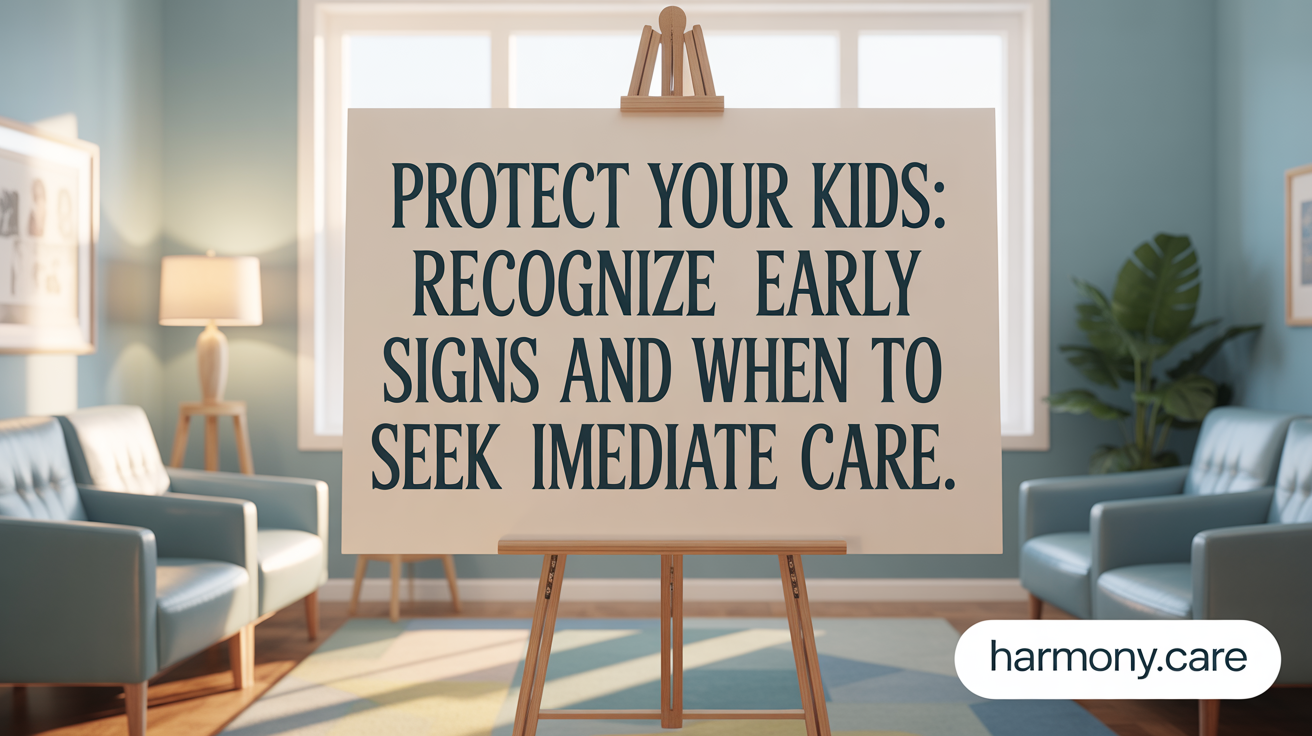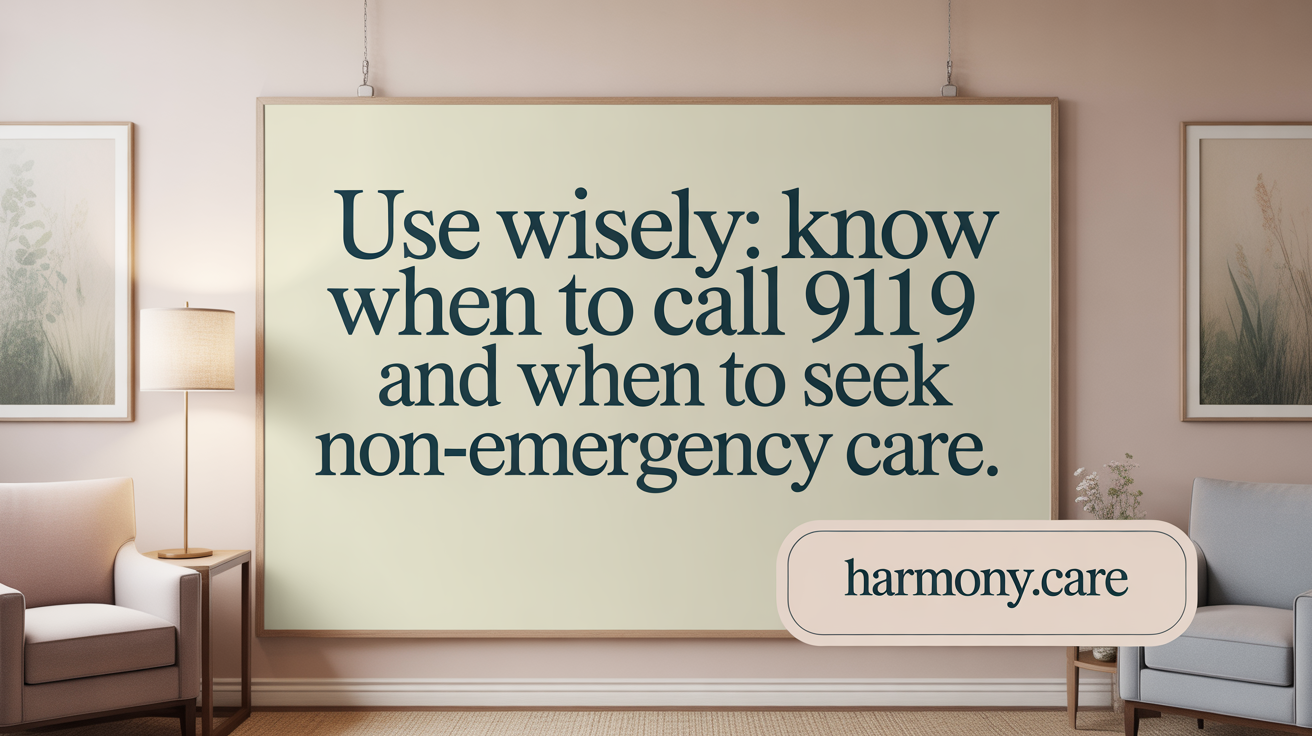Understanding the Critical Moments to Act on Medical Emergencies
Knowing when to seek immediate medical attention at home can be life-saving. This guide helps you identify warning signs that require urgent or emergency care, distinguish between minor and serious conditions, and decide when to call emergency services or visit urgent care or the ER.
Key Symptoms That Demand Immediate Emergency Medical Attention

What signs and symptoms require immediate medical attention?
Recognizing the signs that indicate an emergency can save lives. Immediate medical attention is necessary if a person exhibits chest pain or discomfort that lasts two minutes or more, especially if it's severe or radiates to the arm, jaw, or back. Difficulty breathing or severe shortness of breath also warrants urgent care.
Another critical symptom is sudden weakness, paralysis, or difficulty speaking, which are signs of a stroke. Uncontrollable bleeding that does not stop with direct pressure needs prompt treatment.
Loss of consciousness, seizures—particularly if they are prolonged or first-time seizures—can be life-threatening. Severe head injuries presenting with vomiting or confusion call for urgent evaluation.
Sudden and intense pain anywhere in the body, especially in conjunction with other symptoms such as high fever with neck stiffness or mental confusion, requires immediate attention. Severe allergic reactions involving swelling of the face, lips, or tongue also demand urgent care.
In all these cases, calling 911 or heading directly to the emergency room is essential to ensure swift intervention. Knowing these signs helps in acting fast to prevent lasting harm or death.
Life-threatening symptoms at home
Certain symptoms in adults and children are clear signs of emergencies that need quick action. Severe bleeding that won’t stop, trouble breathing, loss of consciousness, or seizures are some examples. Severe head injuries, deep wounds, or burns also require urgent attention.
Children showing signs such as unresponsiveness, difficulty breathing, or uncontrolled bleeding need immediate emergency care. The same applies to infants with symptoms like high fever, persistent vomiting, or lethargy.
When to call 911
Any situation involving potential life-threatening conditions—such as chest pain, difficulty breathing, severe bleeding, or unconsciousness—calls for immediate dispatching of emergency services by dialing 911.
You should also call 911 if someone chokes and cannot breathe, sustains a head or spinal injury, experiences a severe allergic reaction, or has a serious burn or chemical/electric burn.
Recognizing stroke, heart attack, severe bleeding, and breathing difficulties
- Stroke: Sudden weakness, slurred speech, trouble walking, or facial drooping
- Heart Attack: Chest pain or pressure lasting over 2 minutes, radiating pain to the arm, neck, or jaw, coupled with sweating or nausea
- Severe Bleeding: Wounds that won’t close or bleeding through a bandage after pressure application
- Trouble Breathing: Sudden or severe difficulty breathing, cyanosis (bluish lips or fingertips), or wheezing
In all these cases, immediate emergency response improves survival chances and reduces the risk of long-term disability.
Understanding these symptoms ensures quick action when every second counts, helping you respond effectively in critical moments.
Distinguishing Between Urgent and Emergency Medical Situations

How can I differentiate between urgent medical situations and emergencies?
Understanding the difference between urgent care and emergency care is critical when deciding how to respond to a health issue.
Urgent medical situations involve conditions that need prompt attention but are not immediately life-threatening. Examples include minor cuts requiring stitches, ear infections, or moderate flu symptoms. These issues typically require care within 24 to 48 hours to prevent worsening.
Emergencies, on the other hand, are situations where there is an immediate threat to life or long-term health. Conditions such as severe bleeding, chest pain signaling a heart attack, sudden unconsciousness, significant head or spinal injuries, and severe difficulty breathing are classified as emergencies. These require immediate response by calling 911 or going directly to the emergency room.
The primary factor in differentiating is the severity and speed at which symptoms develop. If symptoms are severe, rapidly worsening, involve vital functions like breathing or consciousness, or could cause permanent damage, emergency services should be contacted immediately. For less critical issues that still need prompt attention, urgent care facilities are appropriate.
Recognizing these distinctions can save lives and ensure individuals receive the proper level of care.
| Condition Type | Symptom Severity | Recommended Action | Examples | Response Time |
|---|---|---|---|---|
| Urgent Care | Moderate, non-life-threatening | Seek treatment within 24-48 hours | Minor wounds, sinus infections, mild flu | Hours to a day |
| Emergency | Severe, life-threatening | Call 911 or go to ER immediately | Heavy bleeding, chest pain, head injury with passing out | Immediate |
Appropriate Actions and Responses for Medical Emergencies at Home

What are the appropriate responses to a medical emergency occurring at home?
During a home medical crisis, the first step is to ensure the safety of everyone present. If the emergency involves an unresponsive or severely bleeding individual, call 911 immediately. Promptly providing life-saving aid such as CPR or rescue breathing can be crucial; follow the ABCDE approach: airway, breathing, circulation, disability, and exposure. Use an automated external defibrillator (AED) if one is available and you are trained to do so.
It’s essential to keep emergency medical information easily accessible, including allergies, existing health conditions, and medications. Remaining calm helps to comfort the patient and prevents panic, which can hinder decision-making.
Preparation is key — having a well-stocked first aid kit and knowing basic emergency procedures can significantly improve the chances of a positive outcome. Assess the situation carefully before acting, and do not move the person unless necessary to prevent further injury.
Quick, effective responses can make all the difference in saving lives and minimizing health complications.
Medical Emergencies and Urgent Care Considerations for Children

What signs indicate that a child needs emergency care?
Children often cannot communicate their symptoms as clearly as adults, making it crucial for caregivers to recognize serious warning signs. Immediate emergency care should be sought if a child exhibits difficulty breathing, unresponsiveness, seizures, head injuries with vomiting or loss of consciousness, severe bleeding, signs of poisoning, or a high fever of 103°F or higher in infants and young children. Visible signs such as cyanosis (bluish lips or face), inability to speak or move normally, swelling of the face or tongue indicating an allergic reaction, or a significant injury like a deep cut or broken bone that protrudes through the skin are urgent indicators.
When is urgent care appropriate for children?
For less severe conditions, urgent care is suitable. This includes situations like minor cuts needing stitches, ear infections, rashes, moderate asthma or breathing difficulties, dehydration with symptoms like dry mouth or no tears, persistent vomiting or diarrhea, or mild fever. It provides quick medical attention without the need for a full emergency room visit.
Pediatric-specific emergency symptoms to watch for include:
- Trouble breathing or persistent wheezing
- Seizures lasting more than a few minutes or first-time seizures
- High sustained fever in infants under three months
- Loss of consciousness or unresponsiveness
- Severe head injury with vomiting or confusion
- Severe head or neck trauma
- Severe allergic reactions with swelling of face or tongue
- Significant bleeding or deep wounds
- Signs of poisoning such as ingestion of toxic substances
- Sudden weakness, inability to stand or walk, or sudden facial drooping, which could indicate stroke.
Guidance for caregivers during emergencies
Caregivers should remain calm, call 911 or the nearest emergency services immediately, and follow instructions provided by emergency responders. While waiting, ensure the child is in a safe and comfortable position, monitor their vital signs, and provide rescue breaths or CPR if necessary. If the child is unconscious but breathing, place them in the recovery position to prevent choking. It’s essential to seek specialized pediatric emergency care when available, as staff are trained to manage children's unique needs.
| Symptoms | Urgency Level | Action to Take | Notes |
|---|---|---|---|
| Difficulty breathing | Emergency | Call 911 or go to ER | Signs include wheezing, cyanosis, or gasping |
| Seizure (first-time or prolonged) | Emergency | Call 911 or go directly to ER | Do not restrain the child; clear the area |
| Loss of consciousness | Emergency | Call 911 | Monitor breathing and pulse |
| Severe head injury | Emergency | Seek immediate care | Symptoms like vomiting, confusion, or drowsiness |
| Severe allergic reaction | Emergency | Call 911 | Swelling of face, tongue, or difficulty breathing |
| Uncontrolled bleeding | Emergency | Call 911 or go to ER | Apply pressure until help arrives |
| Moderate fever (102°F or higher) | Urgent if persistent | Urgent care or pediatrician | Especially if accompanied by rash or lethargy |
| Mild illness (ear infection, rash) | Non-urgent | Wait or visit a pediatric clinic | Usually manageable with home care and over-the-counter medication |
Being prepared and aware of pediatric emergency signs can greatly improve outcomes. Remember, when in doubt, it’s best to seek immediate professional help.
Guidelines for When to Call Emergency Services vs. Non-Emergency Help and When to Avoid ER Visits

When should I call emergency services versus non-emergency medical services?
Knowing when to call emergency services like 911 is crucial for timely intervention. Emergency calls are necessary when someone shows life-threatening symptoms such as severe chest pain, choking, uncontrollable bleeding, sudden loss of consciousness, or neck and spine injuries with loss of feeling. These signs require immediate help to prevent permanent disability or death.
For less urgent health issues—like minor cuts, coughs, cold, or routine injuries—contact non-emergency services or visit your primary care doctor. Many communities have non-emergency medical lines or services such as dispatchHealth, which provide same-day care for non-critical problems. Using 911 for non-critical issues can delay aid for those in urgent danger and strain emergency resources.
Overusing emergency services for minor ailments not only prolongs waiting times but also risks diverting critical care capacity from truly severe cases.
When is it recommended not to go to the emergency room?
Avoid visiting the ER for minor everyday health concerns, such as mild colds, minor skin cuts that stop bleeding quickly, or routine medication refills. These conditions can often be managed through a visit to your primary healthcare provider or at a walk-in clinic.
Emergency rooms are best reserved for serious or life-threatening conditions. Examples include chest pain, uncontrolled bleeding, difficulty breathing, serious head injuries, or symptoms of stroke or heart attack. Overburdening ERs with non-urgent cases can reduce the quality of urgent care for those who need it most.
Rationale for reserving ER visits for serious cases
Emergency departments are equipped and staffed to handle severe and complex problems that require immediate intervention. When we reserve ER resources for genuine emergencies, it ensures quicker response times, accurate diagnosis, and effective treatment for those in critical need.
Misuse of emergency services for minor issues not only increases wait times but also contributes to higher healthcare costs and resource shortages. Proper triage—knowing when to seek emergency help versus urgent or primary care—is essential for maintaining an efficient healthcare system.
Empowering You to Act Swiftly and Wisely in Medical Emergencies
Timely recognition of serious symptoms and choosing the correct level of care can be life-saving. Always trust your instincts — when in doubt, err on the side of caution and seek emergency help. Being prepared with knowledge and resources ensures you can respond confidently to medical emergencies at home, providing the best outcomes for you and your loved ones.
References
- First Aid Tips: Treating At Home vs Visiting Urgent Care
- When to use the emergency room - adult - MedlinePlus
- When To Seek Medical Care for an Illness or Injury
- DispatchHealth - Urgent Care at Home - Inova
- When to Treat a Child at Home or Seek Medical Care - Banner Health
- When To Go To Urgent Care | Medical House Calls
- When to seek emergency room care — and when not to
